It seems there is no astronomical event that can affect humans as deeply as a total solar eclipse. It's one of my favorite astronomical events. But there are also lunar eclipses that can be dramatic and exciting as well. Here at Astra's we have been talking about eclipses for many years. In general, astronomers are referring to an alignment of three celestial objects, the Earth, the Moon and the Sun. An eclipse is also an occultation, when a body is completely hidden from the view or a transit when the eclipsed body is only partially hidden.
Eclipse can mean a solar eclipse, when the Moon's shadow crosses the Earth's surface, or a lunar eclipse, when the Moon's orbit takes it into the Earth's shadow. On this site, information on lunar and solar eclipses is available. We present many illustrations on these pages, please realize that they are simplifications of the complex mechanics that govern the orbits of the Moon and Earth.
What is an astronomical eclipse?
Here on the Eclipse home page we are starting at the beginning, and so here is the definition of eclipse from Google’s English and Oxford Languages. This is the astronomical definition:
e·clipse /əˈklips/
noun an obscuring of the light from one celestial body by the passage of another between it and the observer or between it and its source of illumination. Such as, "an eclipse of the sun"
verb (of a celestial body) obscure the light from or to (another celestial body). Such as, "as the last piece of the sun was eclipsed by the moon"
Have you ever noticed that the disk of the Sun and the Moon appear to be about the same size in the sky? In fact, to observers on the Earth they are very close. The Sun is 400 times larger than the Moon and it is also 400 times farther away so that it appears that the Sun and the Moon are about the same size. This "apparent size" is also called "angular size". The apparent size of the Sun and the Moon changes depending on the distances they are away from the Earth.
The Earth and the Moon are in orbit around the Sun, in addition the Moon is orbiting the Earth. Orbits are always ellipses, although some may be nearly circular. In an elliptical orbit, there are two points, one at the closest distance and another at the furthest. This means that the disks of the Moon and Sun are slightly larger at the close point (we use the term "peri-"), and slightly smaller at the far point (we call that "ap-"). In addition the Moon’s orbit is inclined to the ecliptic by 5 degrees, that is the plane of the Earth’s orbit around the Sun. This means that the Moon moves north and south in relation to the Earth's equator like a yo-yo on a string. Only when the Sun and the Moon are at the same point on the ecliptic (called nodes) can an eclipse occur.
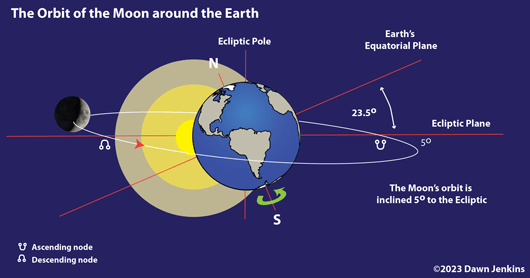
In this illustration of the orbit of the Moon around the Earth with the Sun is shown at a distance. The straight line that marks the ecliptic plane represents the plane that is created by the orbit of the Earth as it is in motion around the Sun. The Moon is a 5-day old waxing crescent and is moving toward the right in this image. The Moon will be full when the Sun is directly behind the Earth. Every time the Moon completes an orbit of the Earth, it crosses the plane of the ecliptic because of its inclination. The moon is said to be at ascending node or descending node, depending on whether it is moving (ascending) northward as seen by Earth bound observers or southward (descending.) The place where the Moon crosses the node is important too, because it changes slightly every month, until the moon orbits around the Earth for 18 years when the Moon completes the cycle it starts all over. It is only when the Sun is located at the Moon's node that an eclipse can occur. In this diagram, an eclipse is not going to occur because it appears that the Sun will be not be at the node when the Moon is crossing.
If the Moon was in a perfect orbit above Earth's equator, every moonth (month) would bring a total solar eclipse and a total lunar eclipse. When the Sun, Moon, and Earth are all at that same point, the term "syzygy" is used. This term means that three bodies are at that special intersection point. It's a fun word that you may hear used to describe a solar or lunar eclipse. (But you can't use it for Scrabble™ because there are three y's.) Because all of the orbits are stable, this happens on a regular basis, about every 6 months, that is called an eclipse season. There are approximately 2 eclipse seasons per year.
A "total solar eclipse" occurs when the Moon is closest to the Earth at perigee. When the Moon is closer to apogee, a different kind of eclipse occurs; that is called an "annular solar eclipse" because the Sun's disk pokes out from behind the moon's disk and appears as a ring of light. There is no total darkness even when the Moon is perfectly centered in front of the Sun. Whenever the Moon does not completely cover the disk of the Sun, it is called a partial eclipse. During any central eclipse, localities away the umbral path will see only a partial eclipse. The best solar eclipses occur when the moon is near perigee and the Earth is near aphelion. Although an annular eclipse is technically a partial eclipse, they are usually not called partial.
A "lunar eclipse" occurs only when the Moon is full because the Sun that illuminates its surface is aligned behind the Earth. An important term used in eclipses is "umbra". Umbra means shadow. In the case of the Earth and Moon, they cast a shadow that is shaped like a cone. The cone of Earth's umbra continues to move through the solar system and could be detected from Mars and beyond, although it would be very tiny. Spherical bodies also project a fainter shadow cone that is called the penumbra. The shadow of the penumbra is much fainter than the umbra. When the Moon only enters the penumbra cast by the Earth a different kind of eclipse occurs; that is called a "penumbral lunar eclipse".
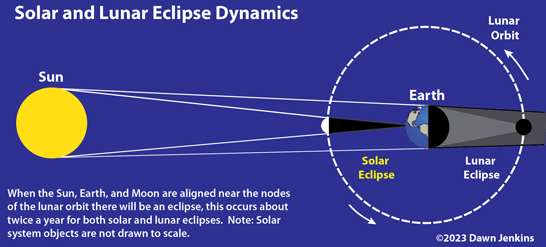
- - For more detailed information on Solar Eclipses or Lunar Eclipses check the pages in Astra's Eclipse Guide.
The total number of eclipses in a year is not constant. There can only be a maximum of seven eclipses in a year. If a year contains seven eclipses, there will be four solar eclipses and three lunar eclipses. The reason for this is the complex orbit of the Moon. The Moon's orbit is the mechanism for causing eclipses. The least number of eclipses that can occur in a year is two; these would be solar eclipses. On average there are 2.4 eclipses per year.
The figure below shows how the frequency of eclipses really works. The easiest way to remember this is that the Moon is closer to the Sun when a solar eclipse is possible. Incidentally, the disk of the Sun that appears to be about equal to the disk of the Moon is much larger than the Moon's orbit around the Earth! Think about how much closer the Moon is to the Sun when it on the Sun side of the Earth. The average diameter of the Moon's orbit is 480,000 miles or 768,000 km.
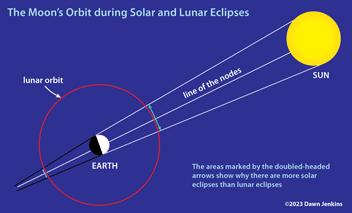
The complex orbit of the Moon is governed by various forces of the Earth and Sun as well as other solar system objects. The long period of time that the large bodies of the solar system have been spinning together in space has caused the Earth and Moon to fall into regular patterns. The forces at play are very consistent. This leads to the Sun-Earth-Moon system eclipse events to occur in patterns that were recognized by careful observations until humans realized that the pattern of eclipses can be calculated. Today we call that pattern, the "Saros Cycle".
The Saros cycle is a period of approximately 6,585.3 days (18 years 11 days 8 hours). It was originally used to predict lunar eclipses, but the cycle is also applied to solar eclipses today. The Saros Cycle is built on three of the Moon's orbital periods - - the Moon's synodic month is from new moon to new moon, lasting 29.53 days or 29d 12h 44m 03s; the Moon's anomalistic month is from perigee to perigee, lasting 27.55 days or 27d 13h 18m 33s; and the Moon's draconic month is from node to node, lasting 27.21 days or 27d 05h 05m 36s. One Saros is equal to 223 synodic months. And coincidentally, 239 anomalistic months and 242 draconic months are within a couple hours of this same period.
For all eclipses, any two eclipses separated by one Saros cycle have similar geometries. They occur at the same node when the Moon at nearly the same distance from Earth and at the same time of year. But the Saros period is not equal to a whole number of days, so the eclipses are visible from different parts of the globe. The difference of about a third of a day means that Earth must rotate an additional ~8 hours or ~120 degrees with each cycle. For solar eclipses, the shifting of each eclipse path shifts by ~120 degrees westward. In a Saros series, the eclipse returns to about the same geographic region every third Saros or 54 years and 34 days. A Saros series doesn't last indefinitely because the three lunar months are not equal to each other.
Saros eclipse cycles today are numbered. Solar eclipses that occur near the Moon's ascending node have odd Saros numbers. The next eclipse in the series shifts southward with respect to the center of Earth. Solar eclipses occurring near the Moon's descending node are given even Saros numbers. Each succeeding eclipse in the series will shift northward with respect to the center of Earth. At any given time around 40 Saros cycles are producing eclipse events.
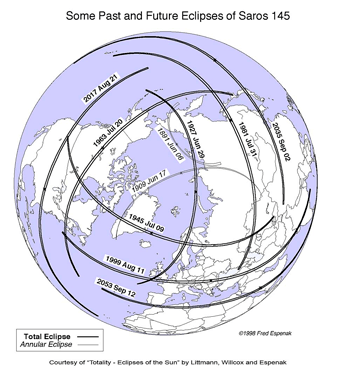
In a Saros cycle there are many eclipses. Solar eclipses and lunar eclipses have separate Saros cycles. The numbering system used today for the Saros series was originated by G. van den Bergh, a Dutch astronomer. Many eclipses comprise a Saros cycle, according to NASA, "A series may last 1226 to 1550 years and is comprised of 69 to 87 eclipses, of which about 40 to 60 are central (i.e., total, hybrid or annular)." A Saros eclipse cycle begins at the poles as previously mentioned, the last eclipse in the series will be occur near the opposite pole.
The cycle was named by Edmond Halley using taken from an 11th century manuscript called, "The Suda". The word was used by the Greeks but it was allegedly taken from the Babylonian word "sāru" that was used for the number 3600. This was an important word as their mathematical system used base 60; the number 3600 is 60 times 60. It is quite appropriate to use the word Saros because the Babylonians and their ancestors were the ones that discovered the eclipse cycle.
Although these pages are still being developed, you will find general solar and lunar eclipse information, and information on some upcoming eclipses. These pages are available by clicking the Eclipse Site Menu button near the upper right side of the page. These are the topics that are available now. The unavailable link will take you to a test page where you can navigate back through Astra's eclipse site or move on to other pages at Astra's.
This site includes a page devoted to the Total Solar Eclipse of April 08, 2024 as well as the annular solar eclipse. An annular eclipse occurs when the moon is too far from the Earth to cover the entire disk of the sun. Later this year, the October 2023 Annular Eclipse will occur when the Sun's disk will be 99% covered. The path goes through the Americas so we are in for a treat. Use this site to catch up with this event. We've given the details of the total eclipse for those who are located on the centerline at greatest eclipse. If you don't understand the last sentence, this site will help you to understand the mechanics of the eclipse and graphic depictions of lunar and solar eclipses.
You can find out about the last most exciting total eclipse to stun North Americans, the Total Solar Eclipse of August 2017. Astra keeps a site devoted to that event that you can visit. The link highlight will take you to the home page of that eclipse by opening a new window so that you can navigate back to this page. Most of the links on this site will remain in one window unless they are external links. As we come closer to the time the eclipses discussed on the site will occur, more information will be available at Astra's.
| Greatest Eclipse | Greatest Duration |
|---|---|
|
Lat. 25° 17’ N Long. 104° 8.3’ W Duration 4m 28.1s |
Lat. 25° 55’ N Long. 103° 31’ W Duration 4m 28.2s |
The April 8, 2024 total solar eclipse is part of Saros cycle 139, repeating every 18 years, 11 days, or 223 lunar months. Saros 139 contains 71 events. The August 21, 2017 total solar eclipse was a part of Saros cycle 145, repeating every 18 years, 11 days, or 223 lunar months.
A Note from Astra:
The phenomena of total solar and lunar eclipses are often called "rare" events. Although they are rare, the occurrence of these is due to the regular and stable orbits of the Moon and the Earth. Attached to each other due to the observable effect of gravity, the planet Earth and its Moon have been orbiting our Sun for millions of years, perhaps as long as 4.5 billion years. Their orbits are regular and steady, they are considered to be in stable orbits. This consistent orbital motion is measurable and that means solar and lunar eclipses can be calculated. Eclipses are the product of regular orbits, and observers on the surface of Earth are treated to the spectacles on regular, calculable cycles. (or even series of cycles) For observers at the surface, the orbits are quite complicated so that many arguments must be known to make accurate predictions. The point is, they are predictable. Eclipses are not omens sent to humans by omniscient gods or other entities. They don't predict the fall of nations or tell you if you are going to get a new job. The same is true for other astronomical phenomena like planetary conjunctions. These phenomena are caused by mechanical processes that are well understood by astronomers and physicists.
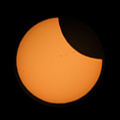
Please feel free to point others to this URL. Images on this page are NOT in the public domain in the U.S.A. The text on this page is copyrighted, ©2023, by the author, Dawn Jenkins, and is NOT released into the public domain. It should not be copied to another site without permission or otherwise published without contacting and crediting the author. Seriously, just ask!
Please read the copyright statement linked below. For more information and other permissions use Astra's Contact Page